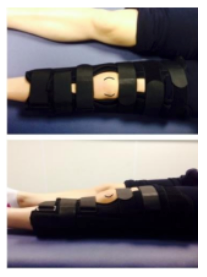This leaflet answers common questions about patella dislocations. If you would like further information, or have any worries, please do not hesitate to ask your nearest clinician.

What is a patella dislocation?
This is when your kneecap comes out of joint.
Healing
It normally takes six to twelve weeks for the injury to heal; Smoking will slow down your healing. We would advise that you stop smoking while your fracture heals. Talk to your GP for more information.
Pain and swelling
Your knee will be swollen and you will have some pain. Swelling is often worse at the end of the day. Taking pain medication, elevating your foot and using ice or cold packs will help. More information is on the next page. It is normal to have mild pain and swelling for three to six months.
Walking and your brace
The knee brace must be worn day and night. You can only take it off to wash or use a cold pack. You must keep your knee straight and replace the brace when you are finished. You are allowed to put weight on your foot. You may find it easier to use crutches in the early stages.

Exercise and activity
It is important to start exercises as soon as possible. Instructions are further down this page.
Follow up
Routine follow-up appointments are not always needed after a sprain to the knee. Most injuries recover well with self-management. If you have significant pain, instability or still need your brace three weeks after your injury, please contact the virtual fracture clinic. A further consultation may be required.
Caring for your injury
Remember to wear your brace. The specialist will tell you when you no longer need the brace.
This video provides you with a guide for fitting your brace:
NHS video: Fitting a knee brace
Using a cold pack will help with your pain and swelling. You can use an ice pack or bag of frozen peas wrapped in a damp towel. Put this on your knee for up to 15 minutes every few hours. Make sure the ice is not in direct contact with your skin.
Try to rest your knee, especially in the first 24-72 hours. Raise your leg on a stool or cushions so that it is above the level of your hip. This will help to reduce your swelling.
Exercises
Early movement is important to promote circulation and reduce the risk of developing Deep Vein Thrombosis (blood clot). Do these exercises three to four times a day. Start straight away, you do not need to push into pain.
Ankle exercises

Rest with your leg supported. Point your foot up and down. Repeat this 10 times.
Static quadriceps exercise
Rest with your leg supported and straight. Gently tense the muscles in your thigh and try to straighten your knee further. Hold for five seconds and repeat seven to 10 times.
I am struggling with my brace. What do I do?
Ensure all straps are tightened and the kneecap is located centrally in the gap allowed, as it can slip down. If you need more advice, contact the Virtual fracture clinic.
I am diabetic, does this change things?
If you are diabetic, this should be discussed with your clincian.
Driving
You can return to driving when:
- You are no longer using your brace
- You can walk comfortably and
- You can perform an emergency stop pain free.
Always test your ability to drive in a safe environment first.
Fitness for work statement
You can get a fitness for work statement from your GP or the doctor at your Fracture Clinic appointment.
What do I do with my brace and crutches when I no longer need them?
We are not able to use boots again. These should not be returned to the hospital. Crutches can be returned to the fracture clinic or emergency department (A&E).
 Translate
Translate